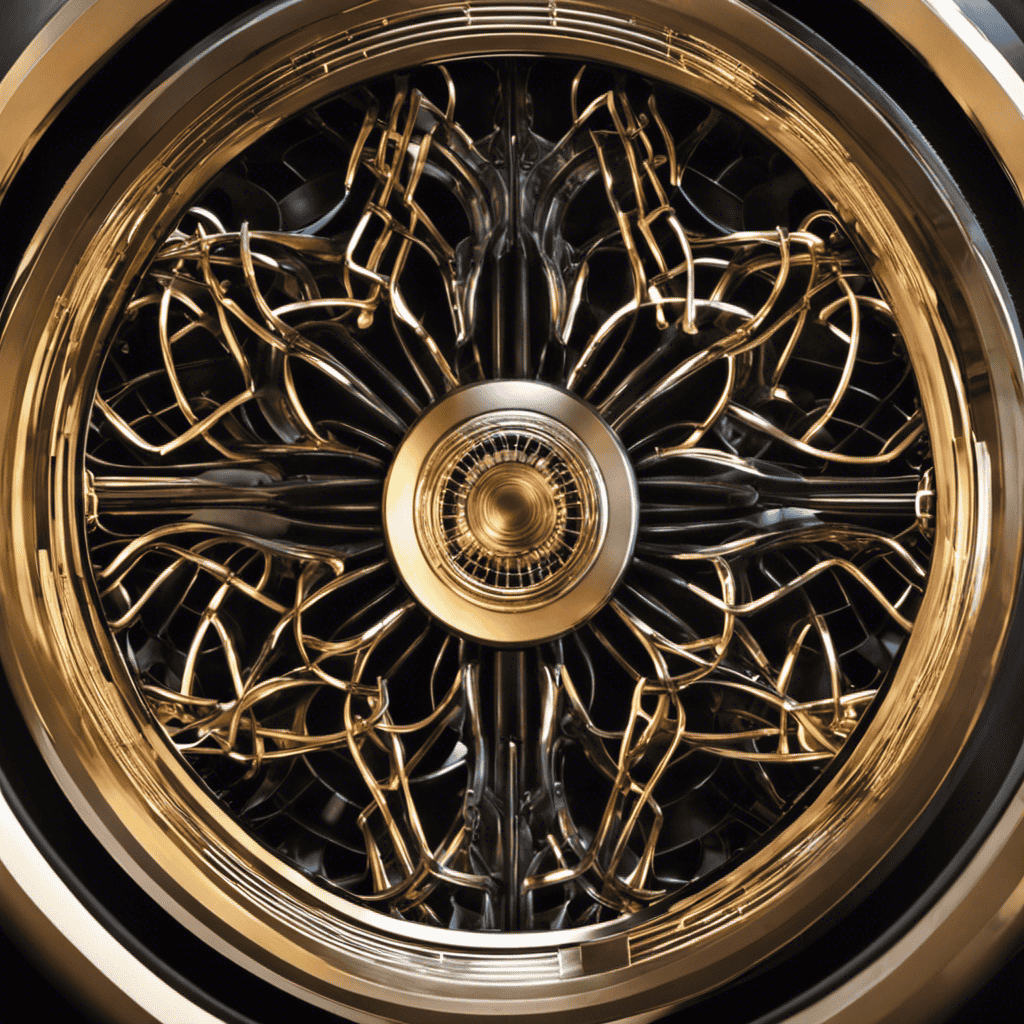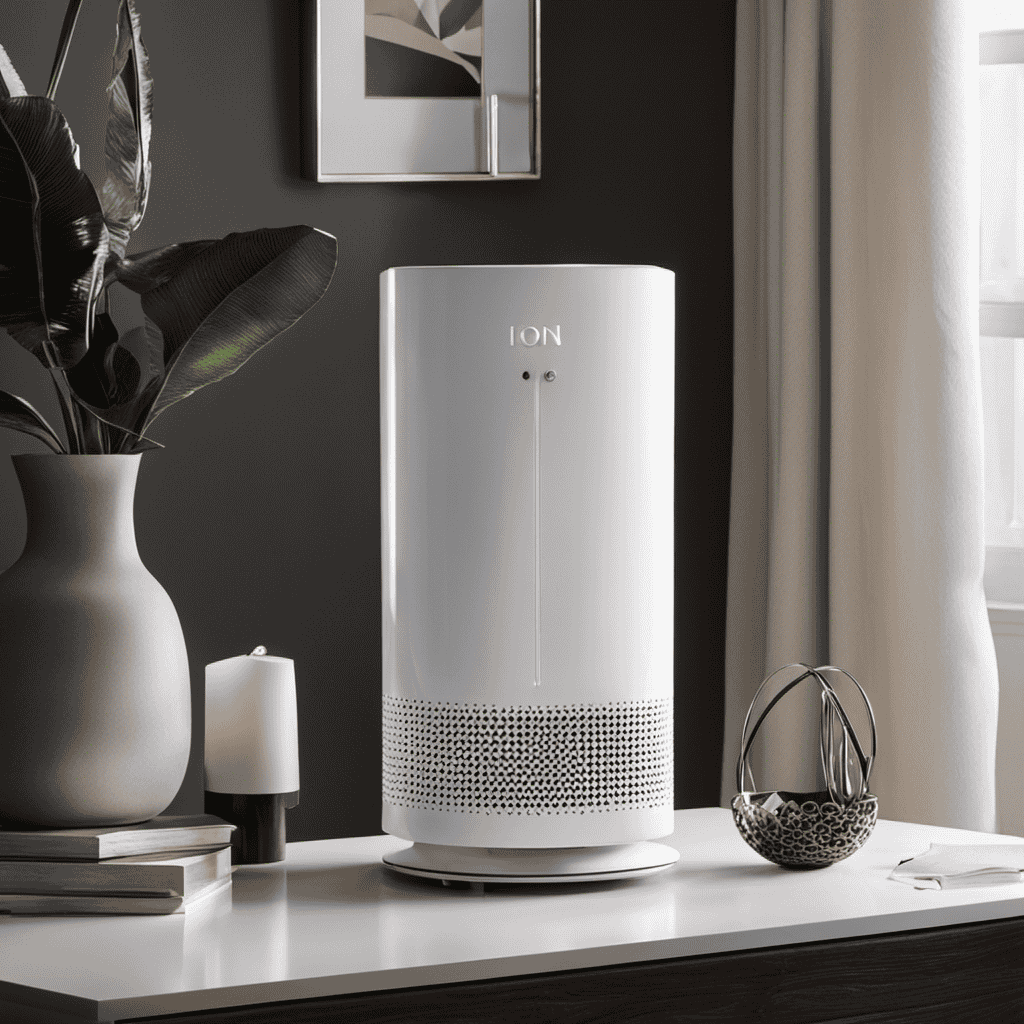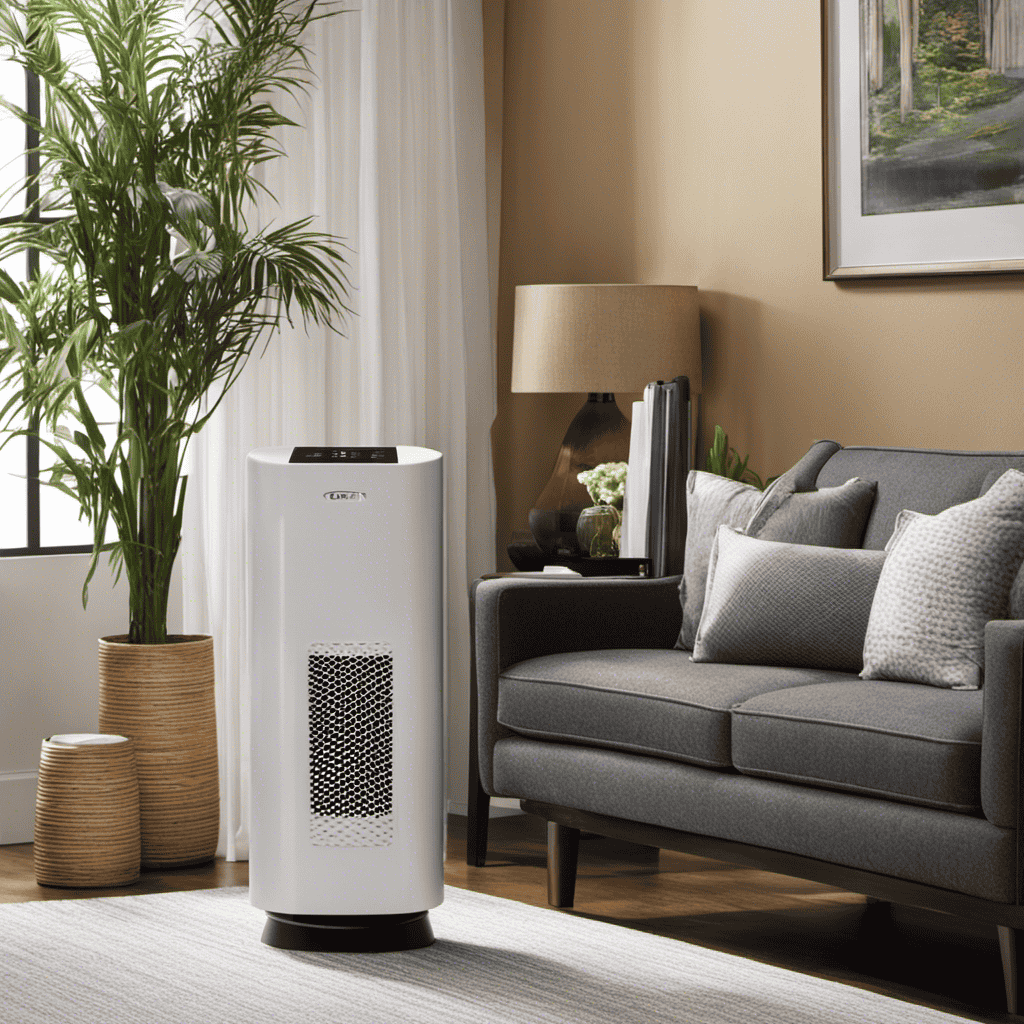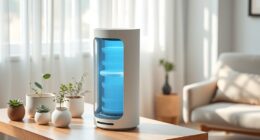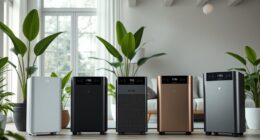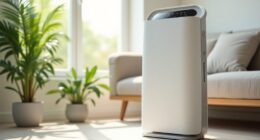Ever wondered how an ionic air purifier actually works? Well, let me break it down for you.
The principles of ionic air purification, the ionization process in air purifiers, and the benefits of this technology are all fascinating topics that we’ll explore in this article.
We’ll also delve into the role of negative ions and the key components of these purifiers.
So, are you ready to uncover the secrets behind this innovative technology? Let’s dive in and find out!
Key Takeaways
- Ionic air purifiers use ionizer technology to remove pollutants from the air by releasing negatively charged ions.
- These ions attach to positively charged particles like dust, pollen, and smoke, causing them to become heavy and fall to the ground or stick to surfaces.
- Ionizers can help reduce allergens in the air by charging particles and causing them to stick to surfaces, providing relief for individuals with respiratory conditions.
- While ionic air purifiers are highly effective at reducing airborne allergens and improving indoor air quality, some models may produce ozone as a byproduct, which can be harmful in high concentrations. It is important to choose one that emits minimal levels of ozone.
Principles of Ionic Air Purification
To understand how an ionic air purifier works, you need to know the principles behind it. Ionic air purifiers use ionizer technology to remove pollutants from the air. These devices release negatively charged ions into the air, which attach to positively charged particles like dust, pollen, and smoke. When the particles become negatively charged, they are attracted to nearby surfaces or collection plates inside the purifier. This process effectively removes them from the air, improving indoor air quality.
The benefits of negative ions also extend beyond air purification. Research suggests that negative ions can help reduce stress, improve mood, and increase mental clarity. Understanding the principles of ionization in air purifiers is essential to grasp how these devices effectively clean the air.
Now let’s delve into the ionization process in air purifiers.
Ionization Process in Air Purifiers
When it comes to ionization and allergies, there is a lot of debate and conflicting information.
Some studies suggest that ionizers can help reduce allergens in the air by charging particles and causing them to stick to surfaces.
However, other research indicates that ionizers may actually worsen allergies by producing ozone, which can irritate the respiratory system.
Therefore, it is important to carefully consider the effectiveness of ionizers and their potential impact on allergies before making a decision.
Ionization and Allergies
Using an ionic air purifier can help alleviate allergies by removing airborne allergens through ionization. When the air passes through the ionizer, negatively charged ions are released into the air. These ions attach themselves to allergens like pollen, pet dander, and dust mites, causing them to become heavy and fall to the ground or stick to surfaces. This process effectively reduces the number of allergens in the air, providing relief for individuals with respiratory conditions.
The benefits of using an ionic air purifier for allergy relief include:
- Improved respiratory health: By reducing the presence of allergens in the air, ionizers can help alleviate symptoms such as coughing, sneezing, and wheezing.
- Enhanced indoor air quality: Ionization technology can effectively remove not only allergens but also other harmful particles like bacteria, viruses, and mold spores, improving the overall air quality in your home.
With its ability to target and eliminate airborne allergens, ionization is a valuable tool for improving respiratory health and maintaining a clean and healthy indoor environment.
Effectiveness of Ionizers
You’ll be pleased to know that ionizers are highly effective at reducing airborne allergens and improving indoor air quality. Ionizers work by using an electrical charge to produce negative ions, which attach to positively charged particles in the air, such as dust, pollen, and pet dander. These particles become heavier and fall to the ground, removing them from the air you breathe.
However, it’s important to note that some ionizers can also produce ozone as a byproduct. Ozone, at high levels, can have potential health risks, including respiratory issues and lung damage. Therefore, when choosing an ionizer, it’s crucial to opt for one that emits minimal levels of ozone. Look for ionizers that are certified by reputable organizations, such as the California Air Resources Board (CARB), which have strict ozone emission standards in place.
Benefits of Ionic Air Purification
The benefits of ionic air purification include cleaner air, reduced allergens, and fresher smelling rooms. Ionic air purifiers are designed to improve indoor air quality by releasing negatively charged ions into the air. These ions attach themselves to harmful particles, such as dust, pet dander, and pollen, causing them to become heavy and fall to the ground. This process effectively removes these allergens from the air, reducing the risk of respiratory issues and allergies.
Additionally, the release of negative ions can also neutralize odors, leaving your rooms smelling fresh and clean. Some of the advantages and features of ionic air purifiers include:
- Low maintenance: Ionic air purifiers do not require filter replacements, saving you time and money.
- Energy-efficient: These devices consume less energy compared to traditional air purifiers.
- Silent operation: Ionic air purifiers operate quietly, ensuring a peaceful environment.
- Compact design: They are often small and portable, making them easy to place in any room.
- Ozone-free: Modern ionic air purifiers produce minimal ozone, ensuring a safe and healthy living environment.
Understanding Negative Ions and Their Role
Negative ions are naturally occurring particles in the air that can have a positive impact on our health and well-being. These ions are formed when air molecules are broken apart by natural processes such as sunlight, radiation, or moving air.
In contrast, positive ions are molecules that have gained an extra electron, resulting in an imbalance in charge. Research has shown that high levels of positive ions can have detrimental effects on our health, such as increasing stress, worsening allergies, and reducing cognitive function.
By introducing negative ions into our environment, we can counteract the harmful effects of positive ions and improve air quality. Negative ions attach themselves to positive ions, neutralizing their charge and causing them to cluster together, making them heavier and thus easier to remove from the air.
This process ultimately leads to cleaner and healthier air for us to breathe.
Key Components in Ionic Air Purifiers
Now that we understand the role of negative ions in air purification, let’s dive into the key components of ionic air purifiers. These devices utilize advanced air purification techniques to improve air quality in our indoor spaces.
The main components of an ionic air purifier include:
-
Ionizer: This component releases negative ions into the air, which attach to particles, allergens, and pollutants, making them heavier and causing them to drop to the floor or stick to surfaces.
-
Collector Plates: These plates are positively charged and attract the negatively charged particles in the air. As the particles are trapped on the plates, they are effectively removed from the air.
Comparing Ionic Air Purifiers With Other Technologies
When comparing ionic air purifiers with other technologies, you’ll notice differences in their methods of improving indoor air quality. Ionic air purifiers use charged ions to remove pollutants from the air. These purifiers emit negative ions, which attach to airborne particles, causing them to become heavy and fall to the ground. This process effectively reduces allergens, dust, and other pollutants in the air.
However, there are pros and cons to consider. The main advantage of ionic air purifiers is their ability to remove particles as small as 0.01 microns, which is smaller than what most HEPA filters can capture. On the other hand, some studies have shown that these purifiers can produce ozone as a byproduct, which can be harmful in high concentrations.
When comparing the cost effectiveness of different air purification technologies, it’s important to consider the initial cost, maintenance, and energy consumption. While ionic air purifiers may have a lower upfront cost and require less frequent filter replacement, they tend to consume more energy compared to other technologies.
Ultimately, it’s crucial to weigh the pros and cons of ionic air purifiers and consider your specific needs and budget when choosing an air purification technology.
Frequently Asked Questions
Can an Ionic Air Purifier Remove All Types of Indoor Air Pollutants?
Yes, an ionic air purifier can effectively remove many types of indoor air pollutants. However, it has limitations and may not be as effective in eliminating certain pollutants like volatile organic compounds (VOCs) or odors.
How Long Does It Take for an Ionic Air Purifier to Clean the Air in a Room?
It takes some time for an ionic air purifier to clean the air in a room. However, the effectiveness and benefits of using one are worth the wait.
Are There Any Health Risks Associated With Using an Ionic Air Purifier?
Using an ionic air purifier may have potential side effects. Research suggests that long term exposure to high levels of ions may lead to respiratory issues and increased risk of asthma attacks.
Do Ionic Air Purifiers Produce Any Ozone?
I’ve found that ionic air purifiers can produce ozone, which can be harmful in high concentrations. However, their effectiveness in removing airborne particles is still debated among researchers.
Can an Ionic Air Purifier Eliminate Odors From the Air?
Yes, an ionic air purifier can eliminate odors from the air. Despite concerns about ozone production, these purifiers use ions to neutralize odors and improve air purification efficiency.
Conclusion
After delving into the world of ionic air purifiers and uncovering their intricate workings, it’s clear that these devices are quite the paradox. While they promise to rid the air of pollutants and improve our indoor environment, their principle of ionization raises eyebrows.
Who knew that the solution to clean air would involve emitting ions that can potentially produce harmful ozone? It’s a case of fighting fire with fire, or in this case, fighting pollution with pollution.
So, next time you turn on your ionic air purifier, remember the irony of the situation and enjoy the clean(ish) air it provides.
